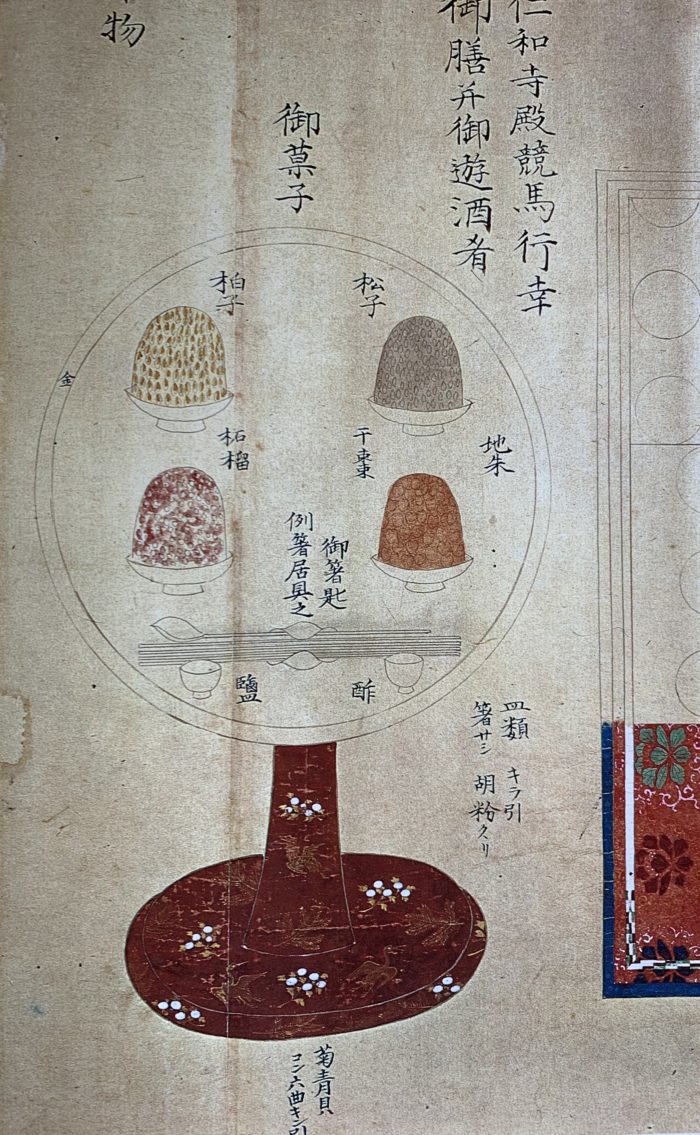Wagashi has been historically established through five stages.
① fruits and nuts
② Mochi(rice cake) and Dango(dumplings)
③ Karagashi from China
④ Tenjin brought back by a Buddhist priest who studied Zen Buddhism in China
⑤ Nanbangashi, a confection brought from Portugal and other places during the voyage
④Tenjin and ⑤Nanbangashi are confections brought from China and Europe since the Middle Ages. This time, I would like to introduce the history of ①~③ ancient confections, especially Karagashi.
In the hunting era, nuts and fruits were important foods as they were, but they could be preserved by drying them out. It is a so-called “natural confectionery”. In the era of agricultural cultivation of grains such as rice, nuts and fruits have become more and more specialty items.
Documents from the 10th century include records of 20 different nuts and fruits dedicated to the central government by local governments.8th century documents also show that local and central governments exchanged rice cakes mixed with beans and rice.
Even now, Japanese people prefer to eat dried fruits and mochi as sweets. For example, dried persimmon. Mochi confectionery has evolved into various types, from baked rice confectionery to dumplings, and is still a major genre of Japanese confectionery.
It is said that the Japanese culture that led to today was almost established around the 16th century, but until then, the influence of China was extremely large. The first impact in the history of confectionery was karagashi, a confectionery from the Tang dynasty of China in the 7-9th centuries. At that time, all the Chinese things were valuable to the upper class in Japan.
It is said that the types of karagashi were as follows. Wheat or rice flour dumplings fried in oil, roasted, or filled with bean paste. Mochi made by mixing meat and fruits of birds and beasts and filling it. Rice cracker made from it.
The picture below shows the offering of the festival that continued at Kasuga Taisha Shrine, which was built in the 8th century. The left is for the year-end festival. It consists of fruits , nuts and karagashi like fried donuts. The upper right is for the New Year. Various karagashi are placed around the rice cakes of ancient Japan. At the bottom right is staffs of the shrine that make karagashi. Since 1200 years ago, the cooking method and materials have not changed much.All photos about karagashi are from the ““Bessatsu Taiyo 36 Wagashisaijiki”(Heibonsha, 1981).




As below, sweets made from fruits, wrapped in rice or soybean flour, and fried in oil have also been left as temple offerings for people wishing for prosperous business and good health(photo below).

In other words, in stage ②, it is used as a gift between powers. At the stage of ③, the Buddhist monks brought back karagashi from China as their study abroad destination and it is used as an offering for religious ceremonies. Already, sweets are both a luxury and a cultural tool.
Today’s confectionery is a Namagashi from Kyoto Tawarayayoshitomi, “Mizu no ne(Surface sound)”. Red bean paste is wrapped in a thin skin made from starch powder. By coloring, a petal of cherry blossoms are falling and the circle of water is spreading.

